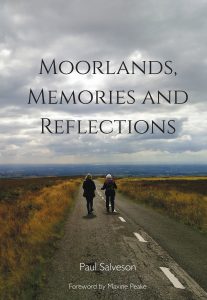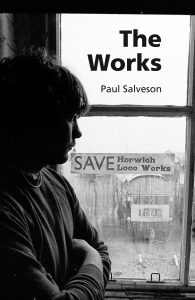The Northern Weekly Salvo
Incorporating Slaithwaite Review of Books, Weekly Notices, Sectional Appendices, Tunnel Gazers’ Gazette etc. Descendant of Teddy Ashton’s Northern Weekly and Th’Bowtun Loominary un Tum Fowt Telegraph
Published at 109 Harpers Lane Bolton BL1 6HU email: paul.salveson@myphone.coop
Publications website: www.lancashireloominary.co.uk
No. 304 June 23rd 2022
Salveson’s half-nakedly political digest of railways, tripe and secessionist nonsense from Up North. Sometimes weekly, usually not; definitely Northern. Doesn’t know the difference between Somerset and Devon.
General gossips
An interesting week ahead. More strikes on Thursday and Saturday and two important by-elections today (Thursday). And I’m off for a few days’ holiday to the South Lakes – by car. My views on the rail strikes are set out below, based on a piece to be published by Chartist magazine in a couple of weeks. Comments welcome, it won’t go down well with some of you. I’ve also revived ideas for a ‘Third Sector’ network of The ‘Manchester Histories’ event at Gorton Moncastery last Sunday
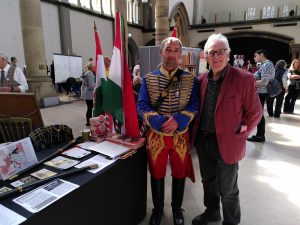
local lines, comments also welcome. As for the by-elections, Labour seems sure to win back Wakefield. Be interesting to see by what margin, and how some of the small independents, such as the Yorkshire Party and Northern Independence Party, fare. I suspect they will get squeezed, as usually happens in by-elections. Tiverton and Honiton is the more interesting. A huge Tory majority that may just fall to the Lib Dems, who have got a strong local candidate who should appeal to the liberal end of the Tory voting public. The two by-elections suggest some intelligent behind-the-scenes co-operation between Labour and Lib Dems, with Labour being given a fairly clear run in Wakefield and the Lib Dems likewise in Devon. It makes sense and encouraging tactical voting is the best way to get a non-Tory government elected.
Rail Strikes: no winners
Unless there is a last-minute settlement, this week’s strikes will go ahead. They are unlikely to be the last, with the rail unions and Government increasingly at odds. Network Rail and the train operating companies are, to a degree, ‘piggies in the middle’.
So what should be the response from progressive-minded folk to the strikes? The knee-jerk reaction from the far-left will be to  enthusiastically champion the cause of the rail unions, hoping it will embarrass an ailing Tory Government. So far, Labour has tried to ride both horses, seeming to offer sympathy to the rail workers while championing the passengers’ cause.
enthusiastically champion the cause of the rail unions, hoping it will embarrass an ailing Tory Government. So far, Labour has tried to ride both horses, seeming to offer sympathy to the rail workers while championing the passengers’ cause.
The Left (the majority of Salvo readers, but not all!) has traditionally supported ‘workers in struggle’, often regardless of the issue. But let’s look at the situation today, in the wise words of V.I. Lenin, making ‘a concrete analysis of a concrete situation’.
The railways are emerging from a gruelling time. During the worst of the Pandemic the trains, at least some of them, kept running and railway staff turned up for work. Rail patronage plummeted and the Government put in £16 billion to keep services operating running and the network in shape. Wages and salaries didn’t go up, but nobody was sacked, or even furloughed. We were being told by Government that public transport wasn’t safe and to either stay at home or – implicitly – use the car. Many people didn’t take much encouragement.
By June 2022, the picture is complex and far from rosy. On the one hand, leisure travel – by definition, discretionary – has surged back and some operators are experiencing strong growth in leisure journeys. However, commuting still lags at around 75-80% of pre-Covid
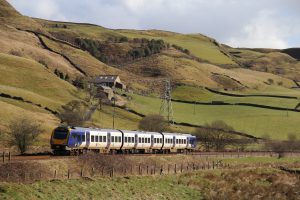
numbers. Revenue is down to about 85% of 2019 figures. Many station car parks which, two years ago, would have been full by eight in the morning are still not much more than half full al day. This reflects people’s changing work habits. Covid accelerated trends that were already becoming apparent: the demise of 5 days-a-week commuting, a growing trend to work at least part of the week from home.
We are a very long way from getting back to the full timetable that existed pre-Covid. In my own part of the world, some routes that enjoyed three trains an hour are down to just one. The reasons for this are less about demand and more to do with availability of train crew. There are still Covid-related absences and the usual steady stream of new entrants with extended training programmes was halted during the Pandemic. There’s a large backlog in some parts of the country.
So what of the strikes? Railway workers can claim, with justification, that they haven’t had a wage rise for over two years and dutifully came into work, with the attendant risks, during Covid. From their perspective, that loyalty is being poorly rewarded. And yet; some railway workers, including drivers, signallers and technical staff are well
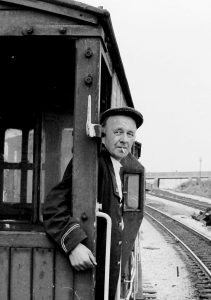
paid. That isn’t true of all railway staff, though the worst paid are often contract staff not employed by Network Rail or the train companies. Many are not members of a union. Interesting that some contract staff will suffer a loss of hours (and pay) during the strikes but get no benefit from any solution as they are not directly employed. The low paid lose out once more.
Winning a strong position in the labour market has taken years of astute bargaining by RMT, ASLEF and TSSA, which didn’t involve actual strikes (other than the threat of action). Any good trade unionist would be conscious of not allowing that position to slip. But at the same time a strong position in the labour market is based on industrial clout within an expanding economic position. Have the rail unions really got that, in 2022? Going back to Lenin’s advice, a careful look at the rail industry would say that it is resting on shaky foundations. Rail use, both passenger and freight, was growing before the Pandemic; the unions were in a strong position to press their members’ case. That doesn’t apply now. Rail could recover, and diversify into other markets such as leisure and also freight. But it faces strong competition not just from the roads but also from lifestyle choices. Take the family for a day trip by train to Blackpool? Or stay local and maybe go and see a film or take a walk? And if you have week after week of disruption, rail becomes less and less attractive an option. The same goes for freight, which is particularly vulnerable to road competition. On top of that, we have a Government that would love to cut the rail unions down to size, with Johnson smashing RMT and ASLEF the way Thatcher did to the NUM. Why make it easy for him?
We can trumpet rail’s environmental benefits until we are green in the face but people will make choices based on convenience, cost and availability. While union leaders talk about these being the biggest strikes ‘since the General Strike of 1926’ we need to remember one thing: we actually lost back then. The miners were defeated, and thousands of railway workers who came out in support of them either didn’t get their jobs back or received pay cuts. Not an experience to emulate.
For the Tories, the strikes are a gift: the one positive gleam on the horizon in an otherwise dreadful political landscape. They can push Labour into a corner and say that they are in hock to the unions. Meanwhile, you can almost hear the knives being sharpened in the Treasury for a new round of rail cuts, with attendant job losses.
The strikes will cause inconvenience and some hardship. The ‘community rail’ lines we’ve worked so hard to develop – routes such 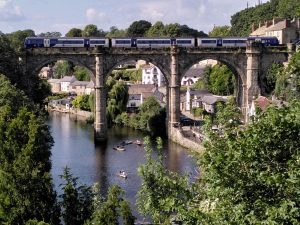 as Esk Valley, Heart of Wales, local branch lines, won’t be getting any trains during strike days as the industry concentrates limited resources on the intercity routes. If it goes on, so much hard work will be lost. Another argument for taking these lines out of the national system and running them as independent social enterprises providing train and bus services (but that’s for another article, see below).
as Esk Valley, Heart of Wales, local branch lines, won’t be getting any trains during strike days as the industry concentrates limited resources on the intercity routes. If it goes on, so much hard work will be lost. Another argument for taking these lines out of the national system and running them as independent social enterprises providing train and bus services (but that’s for another article, see below).
The strikes won’t bring Britain to a standstill, people (and freight users) will make other arrangements – and these could be for the long term. Rail could have a great future ahead of it, providing answers to issues raised by Climate Change and short-term challenges of high fuel prices. Let’s not blow it. There is only one sensible way forward and that is for Government, rail companies and unions to get round the table and hammer out a settlement not just on wages but also on how to shape a future, growing railway which offers the country a sustainable form of transport which underpins economic growth and good quality, providing meaningful jobs for its employees.
What future for ‘Third Sector’ lines?
The current wave of strikes across the rail network illustrate a problem with our ‘unified’ rail network. Basically, behind the veneer of a single railway network there are probably (at least) three sub-networks. These are: intercity; urban/commuter and ‘rural’. Within the third network (‘tertiary’), there’s a sub-species of lines which are relatively self-contained and which are often the first to suffer when there are reductions in service, be it staff shortages, strikes, or lack of rolling stock. They are often the last to get significant investment and business cases for major enhancements are often very difficult to justify. Yet ironically the Government is effectively proposing to expand this
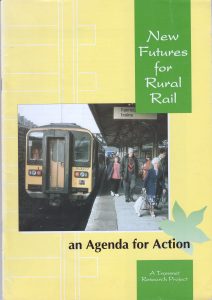
sector through its ‘Restoring Your Railway’ programme. The Okehampton line has already re-opened and there is support for the Blyth and Tyne (Newcastle – Ashington) and Poulton-le-Fylde to Fleetwood, amongst others. The Colne – Skipton line is an obvious re-opening but to an extent it lies outwith the scope of what I’m talking about here; it should form part of a busy, electrified, inter-regional route from Blackpool, Preston and Blackburn to Skipton, Keighley, Bradford and Leeds.
The routes I’m suggesting that need some fresh thinking (OK, a re-hash of mid-90s ‘microfranchising’, but different), number about a dozen, but there’s a degree of flexibility in what would work and what wouldn’t. Included on my list would be:
- Esk Valley (Middlesbrough – Whitby) and Bishop Auckland – Saltburn
- Heart of Wales (Shrewsbury – Swansea)
- Cumbrian Coast (Barrow – Carlisle) and Windermere
- Devon and Cornwall Branch Lines (St Ives, Okehampton, Exmouth, Falmouth, Looe, Newquay)
- Leeds – Skipton – Carlisle and Skipton – Morecambe/Lancaster
- Newcastle – Ashington/Morpeth (not yet opened)
- Nottingham – Skegness
- Birmingham – Rugeley (Cannock Chase Line)
There are others (and nominations welcome). A new approach to these routes and services should ensure that there isn’t an unhelpful ‘break’ in the current service pattern. The experience of lines being artificially truncated has been terrible, e.g. Preston – Ormskirk, Bidston – Wrexham, Wigan – Kirkby. We don’t want to create new basket cases. So any new approach needs to have the flexibility to run ‘onto the main line’ but have control over relevant parts of infrastructure. So ‘Heart of Wales’ for example, would operate over Network Rail/GBR track from Shrewsbury to Craven Arms and from Llanelli to Swansea, and have control of the infrastructure for the central core of the route (including sections that carry freight at the south end).
This has similarities to the ‘Swiss Model’. I can remember, many years ago, the boss of one of the lines (I think the Bern Regional Railway) extolling the virtues of small, focused management but also warning that ‘small is beautiful but too small can be ugly’. So while each line, or small network (e.g. Devon and Cornwall), should have its own local management team and support group (a community rail aprtnership with real power!), there would be advantages in all of the routes to be part of a single entity. Back in the day we called it ‘Community Railways’ but maybe that would be confusing. So how about (Great British) Local Railways (GBLR)?
Ownership is important and it should be obvious that none of the lines suggested here would ever be ‘profitable’ (though the model could help in making them less of a drain on the public purse). So GBLR should be set up with a degree of commercial freedom but with a close link to GBR (once established). A GBLR board would include GBR nominees but also appropriate local authority/combined authority people and social entrepreneurs. At the level of each route there should be a community board with clearly defined powers. The local route, to the outside world, would be clearly branded as a part of the community, not unlike DB has done with some of its local lines e.g. ‘The Usedom Seaside Railway’.
The infrastructure that GBLR controls would be ‘owned’ by GBR and leased to GBLR for them to manage, maintain and operate, over a long period (at least 25 years). GBLR should be a social enterprise, not a contract to whoever can come along and tell us they can operate it cheaply. Again, continental models are relevant here, with a balance between local accountability and commercial/operational flexibility.
The funding for the GBLR should come, initially, from central government funds but this should transfer, over a lengthy period, to more local bodies e.g. combined authority mayors or unitary authorities.
GBLR should have, under its umbrella, devolved management units which should operate with appropriate autonomy, with services that meet local needs. It should also be able to diversify into appropriate sectors including bus and taxi services, tourism-related businesses etc. which bring in additional income. Being a national body it would have flexibility to switch units around as required, share heavy equipment and offer a career ladder for employees. It could also mount national marketing initiatives (much as the ‘Great Little Trains of Wales’ do).
The employment structure should be based on what is appropriate rather than what is inherited from the last century. The aim should be to grow the numbers employed but doing jobs which really add value. So yes, two people on the train but the ‘guard’ would have more commercial duties and the driver should also have more ‘engineering’ functions. Staff would be paid a good rate of pay in exchange for flexibility, at rates which reflect but improve on local labour market conditions.
None of the above is new, we talked about it at length in the late 1990s and early 2000s, and nothing came of it. Perhaps the case is more urgent now. It should be about creating a sustainable local railway in every sense – economically, but also making a meaningful contribution to sustainable development by providing increased services – not just more trains, but feeder buses and stations that are more than dreary unstaffed halts but thriving community hubs. In turn, that means sustainable communities that are attractive places to live and work and not dependent on low-paid seasonal employment, or clogged by traffic.
How? Now is a good time while the Whole Industry Strategic Plan is under discussion and when Great British Railways is taking shape. These ideas failed back in the late 90s not because they weren’t viable but because people were too focused on other things – the early days of privatisation and franchising. It was seen as ‘not worth the trouble’. And the political will wasn’t strong enough. Yet what has become ‘the community rail sector’ has helped drive up usage of many lines dismissed as ‘hopeless cases’. For some – not all – there is scope to go further and look at some more radical ways forward which give these local railways the priority they deserve, rather than always being last in the queue and the first to be stopped when there’s trouble.
Saddleworth Bands Contest
It’s a great Northern tradition and I often manage to miss it – the Saddleworth Bands Contests (note the plural) which normally happen on Whit Friday. There’s been a gap because of Covid but it returned, in full pomp and volume, on Whit Friday just gone, June 3rd. If you’ve 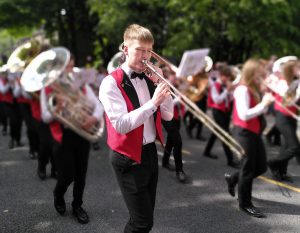 never experienced it, you’re missing something very special and it’s of interest to the transport person as well as a lover of band music. The event takes place in eight villages around the ‘Grater Saddleworth’ area – Delph, Denshaw, Dobcross, Greenfield, Upper Mill , Diggle, Friezeland, Lees and Lydgate. Each band would usually perform at every one, during the evening, starting off just after 4.00. The logistics are fascinating: each band charters its own coach and they move around each location, to a very strict timetable. The local website tells us:
never experienced it, you’re missing something very special and it’s of interest to the transport person as well as a lover of band music. The event takes place in eight villages around the ‘Grater Saddleworth’ area – Delph, Denshaw, Dobcross, Greenfield, Upper Mill , Diggle, Friezeland, Lees and Lydgate. Each band would usually perform at every one, during the evening, starting off just after 4.00. The logistics are fascinating: each band charters its own coach and they move around each location, to a very strict timetable. The local website tells us:
“Often described as ‘the greatest free show on Earth’, the Saddleworth & District Whit Friday Brass Band Contests take place every year on the afternoon and evening of Whit Friday. From the earliest records in 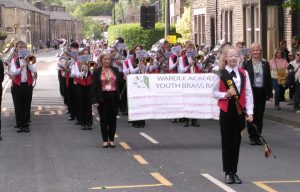 1884, the event has grown in popularity. Now, hundreds of brass bands participate in some twenty different contests at venues scattered around Saddleworth and beyond. All of the contests are open-air, many in delightful surroundings. The area has a very strong tradition of brass band music. In the weeks before Whit Friday, the sounds of rehearsals echo across the hillsides from the various band rooms and village halls. There are thriving bands in some of the tiniest villages. And the best bands are world class. The contests are open to all-comers. So the local youth bands get to match their skills against the top bands of the country. For bandsmen, the dash from contest to contest makes for an exhilarating evening. This is a major event in the brass band calendar and bands travel the length of the country to participate, some even turning up from overseas…..Contests typically start at about 4.30pm. Bands play two pieces (marches), one on the march and then their well-rehearsed
1884, the event has grown in popularity. Now, hundreds of brass bands participate in some twenty different contests at venues scattered around Saddleworth and beyond. All of the contests are open-air, many in delightful surroundings. The area has a very strong tradition of brass band music. In the weeks before Whit Friday, the sounds of rehearsals echo across the hillsides from the various band rooms and village halls. There are thriving bands in some of the tiniest villages. And the best bands are world class. The contests are open to all-comers. So the local youth bands get to match their skills against the top bands of the country. For bandsmen, the dash from contest to contest makes for an exhilarating evening. This is a major event in the brass band calendar and bands travel the length of the country to participate, some even turning up from overseas…..Contests typically start at about 4.30pm. Bands play two pieces (marches), one on the march and then their well-rehearsed 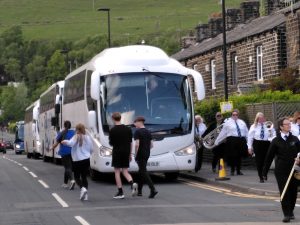 show-piece on whatever passes for a rostrum. Each performance is scored ‘blind’ by an adjudicator, hidden in some adjacent darkened room or caravan. Each contest offers prizes for the best band, best youth band, best soloists etc. At one of the busier venues, you could expect to hear over 50 bands, before the winners are announced shortly after close (10.30 pm or 11.30pm, though the most popular contests can go on well into the early hours).”
show-piece on whatever passes for a rostrum. Each performance is scored ‘blind’ by an adjudicator, hidden in some adjacent darkened room or caravan. Each contest offers prizes for the best band, best youth band, best soloists etc. At one of the busier venues, you could expect to hear over 50 bands, before the winners are announced shortly after close (10.30 pm or 11.30pm, though the most popular contests can go on well into the early hours).”
I opted for just one band-spotting location, Greenfield. It’s a nice spot and I discovered the culinary delights of the local Methodist Church which opens specially and does excellent prato pie. I selected the site of 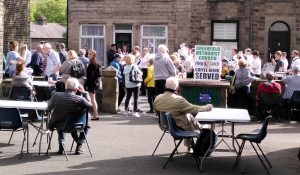 the former Friezeland Loop to watch the first band set off (Wardle Academy) who obliged by playing my favourite march – ‘Slaidburn’ – by Lancashire composer William Rimmer. Magnificent! It really brought tears to my eyes.
the former Friezeland Loop to watch the first band set off (Wardle Academy) who obliged by playing my favourite march – ‘Slaidburn’ – by Lancashire composer William Rimmer. Magnificent! It really brought tears to my eyes.
Getting there and back was easy. I got the 84 bus from Oldham and headed back on the train. The roads were totally clogged. Question: why on earth don’t the organisers, and the railways, make more of the fact you can use the train to get to and from the contest? Greenfield station is a 5 minute walk from the start of the village contest and Upper Mill is easily walkable.
Miniature Railway trashed by thieves will rise again!
Moss Bank Park, Bolton, is one of the many municipal parks around the country which benefits from a miniature railway. It was set up in 1986 but closed some years ago, well before the Pandemic, as the previous operator pulled out. It slowly came back to life a couple of years ago with a small group of enthusiasts taking over. They fettled the track and remaining locomotives and started operating a few months back. Then disaster struck. On the night of June 2nd a team of metal thieves attacked the railway, causing a huge amount of damage. Most of the track was stolen. The group is determined to re-build and has been busy going round the area appealing for support. We held a very well-attended garden party here at 109 Harpers Lane on Sunday, with the Halliwell Garden Railway operating, and a plentiful supply of cakes and teas. Over £500 was raised, but there’s a long way to go yet.
Like to contribute? Send monies to:
Mossbank Park Model Engineers Society Sort code 30-98-97 account number 64512562
Wanderings in West Lancashire
As part of the research for my book Lancastrians (see below) I’ve been having a look at some towns that I’m less familiar with – the likes of St Helens, Ashton-in-Makerfeild, Widnes and Prescot. They’re all quite easy to get to by public transport. A couple of Saturdays back I did a round tour of West Lancashire, via Bolton and on to Wigan. I crossed  over to North Western and the (currently hourly) stopper to Liverpool was sat waiting. Interestingly, the chap in the coffee kiosk was helpfully telling passengers to use the front three cars of the 6-car 331 formation. And his coffee was very nice too. We let the Blackpool – Liverpool ‘fast’ depart and we set off on time, past Springs Branch and through the old mining country around Bamfurlong and Ince Moss.Much of this used to be quadruple track, with heavy coal traffic from the local pits between Wigan, Bryn and Garswood. There are still some traces of it. The local stations – Bryn, then Garswood, were busy with people going into Liverpool for the day. I got out at Prescot, a place I must confess to never having set foot before. The booking office wasn’t busy so I I tried out the quality of local information, asking how to walk up to the town centre. The chap on duty couldn’t have been more helpful, and excellent ambassador for Northern but also for Prescot. The Station House cafe was open but after my coffee and cake at Wigan I reluctantly gave it a miss – but will go back and try it out.
over to North Western and the (currently hourly) stopper to Liverpool was sat waiting. Interestingly, the chap in the coffee kiosk was helpfully telling passengers to use the front three cars of the 6-car 331 formation. And his coffee was very nice too. We let the Blackpool – Liverpool ‘fast’ depart and we set off on time, past Springs Branch and through the old mining country around Bamfurlong and Ince Moss.Much of this used to be quadruple track, with heavy coal traffic from the local pits between Wigan, Bryn and Garswood. There are still some traces of it. The local stations – Bryn, then Garswood, were busy with people going into Liverpool for the day. I got out at Prescot, a place I must confess to never having set foot before. The booking office wasn’t busy so I I tried out the quality of local information, asking how to walk up to the town centre. The chap on duty couldn’t have been more helpful, and excellent ambassador for Northern but also for Prescot. The Station House cafe was open but after my coffee and cake at Wigan I reluctantly gave it a miss – but will go back and try it out.
It wasn’t a long walk up to the town centre but the directions helped (maybe a bit more signage wouldn’t go amiss). The route took me through a new housing estate which was once the site of the large cable factory which was the main local employer. The town centre itself is really a delight, with a pedestrianised main street featuring some
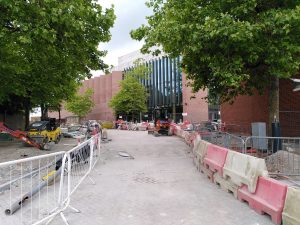
Jacobean buildings and plenty of enticing independent shops. The museum has recently transferred to the 1960s style shopping centre and shares space with the local library. It’s a good little museum with lots about the industrial heritage of the area. Prescot was once a centre of the watch-making industry and developed a thriving local culture amongst the watch-makers who perhaps shared some of the radical views of their colleagues in the Swiss Jura region.
The really big thing happening in Prescot this year is the opening of ‘Shakespeare North’ – a brand new theatre right in the heart of the town centre. Prescot does have Shakespearian connections so the location is highly appropriate. The opening weekend is set for July 5-7, followed by a series of events and performances over the summer. It’s an impressive building and a great initiative by Knowsley Council and its partners.
From Prescot I caught a local Stagecoach bus to St Helens and had time for a cafe and mooch round the new independent Book Shop’ on 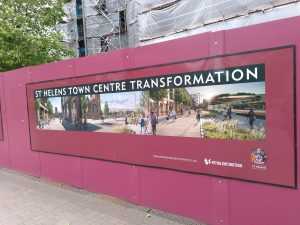 Street. It’s well worth a visit and the coffee is recommended. There’s quite a lot going on in the town centre with a major regeneration project in the town hall area. The enormous Gamble Building is being restored and should open next year.
Street. It’s well worth a visit and the coffee is recommended. There’s quite a lot going on in the town centre with a major regeneration project in the town hall area. The enormous Gamble Building is being restored and should open next year.
The last bit of the ‘unfamiliar’ part of my journey was a bus ride from St Helens to Rainford Junction, taking the half-hour no. 38, operated by Arriva. It goes via the pretty village of Rainford and links nicely with the train at what was once truly ‘Rainford Junction’ with lines from St Helens and Ormskirk linking into the main Wigan – Liverpool route. I never got chance to travel on the Ormskirk (via Skelmersdale) line but did once travel on the line down to St Helens via Rainford and the wonderfully-named village of Crank. It was a Bolton – Chester race 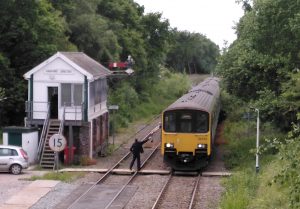 special routed via Wigan, St Helens, Earlestown and Warrington and was hauled, appropriately I suppose, by LMS Jubilee ‘Seahorse’. I wasn’t going to watch the horses, apart from that one, but doing a spotting trip with my dad. It was my first sighting of Great Western locos, with Chester West shed being full of ‘Halls’ and ‘Granges’. The line from Rainford Junction had long been closed to regular passenger services and the tracks were overgrown. Must have been about 1960.
special routed via Wigan, St Helens, Earlestown and Warrington and was hauled, appropriately I suppose, by LMS Jubilee ‘Seahorse’. I wasn’t going to watch the horses, apart from that one, but doing a spotting trip with my dad. It was my first sighting of Great Western locos, with Chester West shed being full of ‘Halls’ and ‘Granges’. The line from Rainford Junction had long been closed to regular passenger services and the tracks were overgrown. Must have been about 1960.
Rainford Junction may soon get a new branch line, to Skelmersdale. The planned route would diverge from the Kirkby line west of Rainford Junction and have a triangular junction allowing trains to continue to Wigan (I think). For now, Rainford Junction seems a sleepy little place, with the signaller still using traditional token apparatus to permit trains onto the single line to Kirkby. How sad that this was once the Lancashire and Yorkshire’s Railway’s main line with Horwich-built ‘Highflyers’ passing through at 125 mph (OK, I exaggerate but not just me). Our class 150 train didn’t get much above 50 mph with stops at Upholland, Orrell and Pemberton before reaching Wigan. Orrell station looking very nice thanks to efforts of the newly-formed station adoption group. I had enough time for a quick look round Wigan and the re-development that’s taking place. I was pleased to see the covered market still operating, always a good place for cheese and plants (the Bickershaw Hall plant stall is excellent). And then, home. A grand day out.
Talks, walks and wanderings
Following the ‘official’ end of the Pandemic, I’ve been getting a number of invitations to give talks on various topics. Recent talks have included ‘Allen Clarke’s Bolton’ for Friends of Smithills Hall, ‘Railways and Railwaymen of Turton’ for Turton LHS, ‘Moorlands, Memories and Reflections’ for What’s Your Story, Chorley? and ‘Railways and Communities: Blackrod and Horwich’, for Blackrod LHS. Other topics are:
- The Lancashire Dialect Writing tradition
- The Railways of the North: yesterday, today and tomorrow
- Allen Clarke (1863-1935) Lancashire’s Romantic Radical
- The Winter Hill Mass Trespass of 1896
- The Rise of Socialism and Co-operation in the North
- The Clarion Cycling Clubs and their Club Houses
- Walt Whitman and his Lancashire Friends
- Forgotten Railways of Lancashire
- Banishing Beeching: The Community Rail Movement
- Railways, Railwaymen and Literature
I charge fees that are affordable to the organisation concerned, to fit their budget – so by negotiation. An average fee is in the region of £40-£50, all in.
My preferred geographical location is within 25 miles of Bolton, ideally by train/bus or bike. However, with sufficient notice I can go further afield..
CRANK QUIZ
Inspired by Britannia, readers are invited to nominate stations which continued to provide some sort of passenger service after they had officially closed. Here’s a few responses – thanks to all!
“Crank quiz: I’m sure I’ve seen a photograph of the Royal Train at Middleton Towers on the former Dereham line, now only open for freight in the shape of sand traffic. Her Majesty joined her train there because of work at Kings Lynn at that time.” (Paul Hadley)
“The station at Eastwood between Todmorden and Hebden Bridge closed some time in the 1950s. The last train from Manchester only ran as far as Todmorden on Mondays to Fridays. National servicemen in the 1950s with a weekend pass who lived beyond Todmorden were conveyed on the steam loco as it returned to shed at Sowerby Bridge. Eastwood with a level crossing was a convenient dropping off point for some.”(Richard Greenwood)
“Britannia-style ‘ghost’ trains: Leicester Belgrave Road handled summer excursions to the east coast at Skegness; Were there workmen’s trains between some or all of Ranskill, Bawtry and Doncaster for railway works staff? I’m pretty certain there were sections of line in South Wales that carried miners’ services after public trains finished.” (Martin Higginson)
This week’s Crank Quiz, inspired by Rainford Junction:
List station or (actual) signalbox names with ‘Junction’ in their title, which are no longer junctions….
READERS’ LETTERS:
Thomas Pitfield: John Le Grove writes:
I very much enjoyed your feature on the composer Thomas Pitfield. Mistaking my phone number for another John – John Moate, Hallé timpanist, Tom invited me round to his home in Bowdon to advise on the percussion concerto he was writing. Feeling completely unqualified to make any useful comment whatsoever, our meeting was interrupted by the real John Moate appearing at the door, to everyone’s amusement. I later went to hear Pitfield’s Percussion Concerto in the Free Trade Hall, and jolly good it was too. People like him contribute so much and yet are too easily forgotten. Thank you for the article. It’s amazing what a disproportionate influence Lancashire has wielded on twentieth-century music.
Foxdenton Hall (Middleton Junction) from Richard Lysons:
Hi Paul, Thanks for mentioning Foxdenton Hall and Lydia Becker. Her biographer, Joanna M. Williams told me that Lydia’s family lived there, but not actually Lydia herself. But she did visit the house regularly. Joanna’s book is The Great Miss Lydia Becker, Suffragist, Scientist and Trailblazer. I must confess that I have not read it (yet). The new cafe at Foxdenton Park is named Lydia’s Tearoom in her honour. Worth a visit- a friendly group of volunteers. Open Wed/Thurs/Fri.
New Projects
My collection of railway-themed short stories – Last Train from Blackstock Junction – is being published by Platform 5, this Autumn. It features 12 stories of railway life in the North of England, and has a foreword by Sir Peter Hendy, Chair of Network Rail. More details soon.
Much of my time this year will be devoted to work on one of my biggest projects – a cultural and social history of Lancashire. Lancastrians will be published by Hurst (who recently brought out the fascinating Northumbrians) next year.
Still in Print (at special prices!)
ALLEN CLARKE: Lancashire’s Romantic Radical £9.99 (normally £18.99)
Moorlands, Memories and Reflections £15.00 (£21.00)
The Works (novel set in Horwich Loco Works) £6 (£12.99)
With Walt Whitman in Bolton £6 (9.99)
See www.lancashireloominary.co.uk for full details of the books (ignore the prices shown and use the above – add total of £4 per order for post and packing in UK)
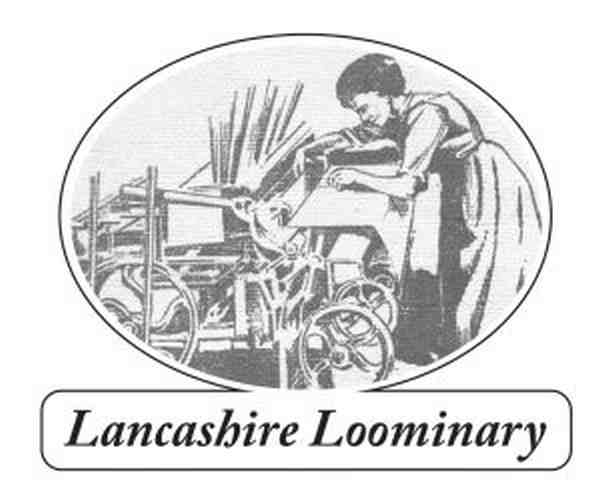
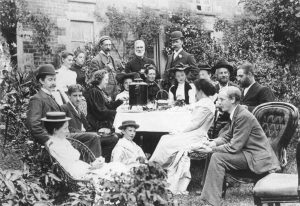
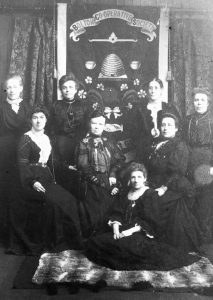
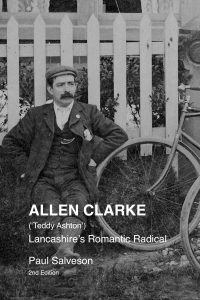 delivery). The book is substantially up-dated from the 2009 edition and has a lot of new material in it, including an entirely new chapter on Clarke’s railway writings. You can download an order form from my website, below, or there’s one at the back of this newsletter:
delivery). The book is substantially up-dated from the 2009 edition and has a lot of new material in it, including an entirely new chapter on Clarke’s railway writings. You can download an order form from my website, below, or there’s one at the back of this newsletter: 